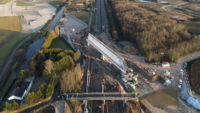Milton-Madison Bridge Earns Title of Longest Slide










The tension was high in Milton, Ky., and Madison, Ind., as crews prepared to slide the new Milton-Madison Bridge's nearly half-mile-long superstructure 55 ft over the Ohio River in one piece. "It'll be good to get this behind us," said Charlie Gannon, project manager for design-build contractor Walsh Construction. Engineered to minimize disruption, the slide became the defining moment of a $104-million project fraught with weather delays, technical difficulties and other challenges.
Believed to be the longest bridge slid laterally in North America and possibly the world, the 2,428-ft-long, four-span steel truss reached its final position on April 10. "It's kind of a 'wow' moment," said Aaron Stover, project manager for Michael Baker Corp., which is acting as construction manager for co-owner Indiana Dept. of Transportation.
 |
| GANNON |
The design-build team of Walsh Construction, Buckland & Taylor Ltd. and Burgess & Niple Inc. holds the bridge contract with INDOT, which, along with co-owner Kentucky Transportation Cabinet, hopes this summer to wrap up the replacement of a 1929-built bridge with a modern, two-lane structure that, at 40 ft, is twice as wide and has shoulders and a sidewalk. Although the bridge's original completion date was fall 2012, officials say the ability to build it on temporary supports next to the old bridge, refurbish the old piers, demolish the old structure and slide the new one into place allowed the team to cut closures from at least a year under conventional methods to less than six weeks using this extreme prefabrication technique.
Year-long closures "would have had a devastating impact on the local economy," explains Will Wingfield, INDOT spokesman. Another benefit, he adds, is that truck traffic can cross the Ohio River here for the first time in years. Before the old bridge was demolished last year, it had a 3-ton weight limit due to rapid deterioration.
Greasing the Skids
The slide called for careful planning and execution. Eight 364-ton-capacity strand jacks—one atop the bridge's two land piers and two on the three water piers—were each rigged with up to 31 strands of 5/8-in.-dia cables. The jacks, provided by Switzerland-based VSL International Ltd., were used previously to hoist two of the truss spans over the water and onto temporary piers composed of some 3,200 tons of tubular steel piling and fabricated steel rising 80 ft over barge-impact frames (ENR 7/23/12 p. MW21). The remaining two spans were built over the water. When the truss was completed last June, traffic switched to the new bridge to allow demolition of the old one.
VSL used a computer system it calls BRAVO to synchronize the slide. Mounted atop each jack, lasers surveyed reflective targets fixed to gusset plates on the 30-million-lb truss. "With the BRAVO system working correctly, they can keep everything within three one-thousandths of an inch," Gannon said.
The strands mated to harnesses, or steel frames, secured the truss's upstream bearings. Threaded rods as big as 1¾ in. in dia extended from the harnesses to frames hooked around the downstream bearings. Under the Teflon-equipped bearings were girders polished to a high shine and greased with a high-temperature lubricant to reduce friction.
In the days leading up to the slide, crews were busy welding, grinding and polishing the runway to ensure a smooth sliding surface. They started with 40-grit sandpaper and worked their way up to 120-grit material, Gannon noted. Sitting on falsework hanging from the upstream side of the piers, the hydraulic jacks pulled the strands up to 20 in. at a time, slowly bringing the truss upstream onto the refurbished piers from the temporary piers.






